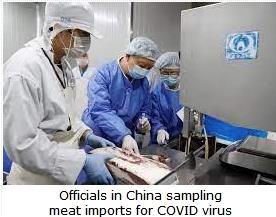 During the first quarter of 2021, China claimed that imported frozen meat products and packaging were contaminated with SARS-CoV-2 (COVID) virus. Product was assayed on arrival from plants in Brazil that recorded high levels of infection among workers. The World Health Organization countered with an opinion that it was unlikely for frozen exported food products to be a vehicle of infection.
During the first quarter of 2021, China claimed that imported frozen meat products and packaging were contaminated with SARS-CoV-2 (COVID) virus. Product was assayed on arrival from plants in Brazil that recorded high levels of infection among workers. The World Health Organization countered with an opinion that it was unlikely for frozen exported food products to be a vehicle of infection.
The Food Standards Agency of the U.K. recently conducted studies on the viability of SARS-COV-2 on a variety of packaging materials and foods. Generally COVID virus could not be isolated from food products 24 hours after inoculation, simulating aerosol contamination under controlled conditions. The survival of SARS-COV-2 was evaluated over a range of temperatures and humidity levels encountered under storage and transport of various food products.
The virus can persist for as long as seven days on produce with uneven surfaces including vegetables and fruits. Pastries were free of virus within hours attributed in part to the presence of arachidonic acid in egg white that coats pastries and similar items. In contrast, virus could persist for as long as a week on cheese and cold meat. Plastic surfaces can support survival for a week but aluminum cans are free of virus after hours.
The level of SARS-COV-2 applied to the foods and packaging material was designed to simulate an infected person sneezing on product representing a worst-case situation. It is generally acknowledged that SARS-COV-2 is spread by aerosol rather than contact with contaminated surfaces. Rinsing fresh produce, cooking meats and personal hygiene including hand washing and masking in plants should reduce the risk of transmitting COVID.
It is questioned whether SARS-CoV-19 virus would remain viable on meat or its packaging over the duration of a 10,000 mile ocean shipment at sub-freezing temperature. The application of PCR assay will detect viral RNA but a positive result would not necessarily indicate viability with the potential for infection. The fact that China continues to import beef, pork and chicken in large quantities without reporting outbreaks in workers in cold storage and product-handling facilities suggests a negligible risk from imported frozen protein products.